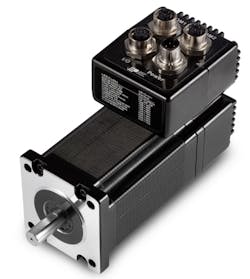Every encoder-based motion-control axis, such as a servo motor or step motor, must know where it is to be accurate. If it doesn’t, it will never reach its target position. But the encoder must first be referenced or calibrated to a fixed position, the axis’s home position, which defines its relationships with the machine’s components. Knowing the home position lets the drive plan motion profiles so they are precisely coordinated with the motions and positions of other components.
Homing Runs
Home positions are established during homing runs. In a homing run, the drive moves the motor back and forth until it detects the signal from the home sensor (a limit switch or sensor mounted next to the axis). When the drive detects the sensor, it captures the encoder information and records that as the motor’s home position. From then on, all motor motions are determined in relation to that home position.
Homing runs are generally done at low speed to ensure an accurate capture of the home sensor and to minimize the risk of a crash if the sensor is not found (due to a broken wire or obstruction, for example). For linear axes with long strokes, homing runs can take the better part of a minute or more. In complex machines, where axes cross other axes, homing routines must often be done serially, one axis after the other rather than in parallel. This avoids collision between axes. Adding together all these slow homing routines stretches power-up times to several minutes or more.
With many encoders, such as incremental and single-turn absolute versions, homing routines are required for every power-up cycle. This means every time a machine is powered down at the end of a shift, or for maintenance or changing from one part to another, homing routines must be done again after the machine powers up. If axes are powered down for safety reasons during emergency stops, add even more homing routines into the mix. This means the line can have lots of downtime and less time in production.
Motion control axes with incremental or single-turn absolute encoders lose their position reference information when powered off. This is worse with incremental encoders which simply provide relative position information from the time they are powered on and homed; the drive keeps a running total of encoder counts from that time and calculates motion profiles based on that running total. Single-turn absolute encoders provide unique information for every position within one rotation of the motor and therefore do not require homing if the axis only moves less than one rotation for all its positions. But most motion control axes need to move more than one revolution when operating.
Multi-turn, Absolute Encoders
Multi-turn, absolute encoders solve the problem of long homing runs and downtime by providing and retaining motor-position information for several thousand motor rotations, even when the axis is powered off for long periods of time. This means a home position established a power cycle ago, a day ago, a week ago or even years ago, is retained by the encoder and the drive can access it when the axis is turned on. It only takes one homing move during the machine’s initial calibration to establish a home position that will endure indefinitely. This eliminates homing moves at every power up, maintenance procedure, changeover and e-stop condition, dramatically reducing downtime while improving productivity.
A few different approaches can be taken to build multi-turn, absolute encoders. All usually start with a basic incremental or single-turn absolute encoder. Then add a battery to keep the circuitry powered even when the axis is off to let the encoder continuously track its position. The downside to this approach is that batteries are large compared to other circuit components and must be replaced regularly. This affects the axis’ size and maintenance requirements.
Another approach is to put a precision gearset between the motor shaft and a single-turn absolute encoder. The gearset would be designed so that it would take thousands of motor rotations to turn the single-turn encoder a full turn. This approach reduces maintenance, but the gearset needs space in the encoder housing and adds significant cost. These make the motor larger and more expensive than other approaches.
A third approach relies on an energy-harvesting technique based on the Wiegand Effect, which generates a pulse of energy whenever the motor shaft is turned. This pulse is enough to power the encoder so that changes in encoder position can be captured when the axis is powered off. There are no mechanical components to wear and no batteries are needed. The result is a compact, cost-effective and maintenance-free multi-turn encoder that retains multi-turn absolute positioning information.
For applications where minimizing downtime is critical, the cost-effective and simple approach is to use multi-turn, absolute encoders on all motion control axes. This eliminates repeated homing routines. It’s also a good idea to use an encoder with Wiegand-based energy harvesting to save money while increasing production and reducing maintenance downtime.
Eric Rice is the technical marketing director at Applied Motion Products.


